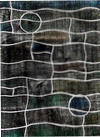

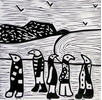
“La promenade”, 1988

same print in color, 3 colors, 3 more blocks
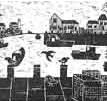

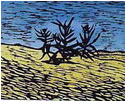
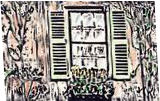
One of my 1st woodcut, 1985

Playing with lines and color, 1985

© Dominique Lecomte 2014
History of printing relief
Introduction
From 500BC to today, printing relief has a long history, and it is also an history you are buying when you buy an original print. Here is how this article is organized: • Beginning (500BC-100AD and 100-1300) • Printing and relief printing (1300-1450, 1450-1600, 1600-1800, 1800-1900, after 1900) • Relief printing and artists • RessourcesBeginning
500 BC - 100 AD • Relief printing techniques are first used by the Egyptians to print on fabric (les indiennes). A piece of wood is cut with a knife, and what is left of the drawing is inked and pressed on the fabric. To get more than one color, one has to cut as many woodblocks as there are different patterns. • Stone is used by Chinese artists to make the seals they will use to sign their artworks, but generally speaking, only ethnic groups with no access to wood, like the Inuits, use this material.On this topic, you can consult: An Illustrated History of Printing in Ancient China (English and Chinese Edition)Printing and relief printing
1300 - 1450 • Crusaders bring back to Europe the secret of paper making and relief printing techniques: the 1st known woodcut is called Bois Protat (made around 1375/1400). • Monks are the ones generally making images: inspired by piety, distributed by religious orders, they are intended to evangelize the populations. When pope Clement IV organizes the gifts of indulgences, the production of these images increases dramaticall “Le Nouveau Monde III”, 1997 “Bison couché”, 1999 • Printmakers get their inspiration from stained-glass windows or paintings found in churches; the pictures come with a short text, first hand- written, then cut in the woodblock itself. Later, someone finds out that it is possible to glue the pieces of paper back to back and to bind them together in order to make books. • Secular pictures like heroes of chivalry begin to appear around 1420, and each region has its own style 1450 - 1600 • Gutemberg (1400-1468) makes the first printing machine: texts and pictures are separated and the prints illustrate the stories, but each print can also be seen as stand-alone. Some printmakers start to sign their artworks. Specialized craftsmen take care of each stage of the book- making - creation of the text, illustration, printing, and so on- • Durer (1471-1528), Holbein (1497-1543), Cranach the Old (1472-1553) are from this period, and they not only use relief printing techniques, but also etching, mezzotints, and dry points to make prints which later will be be published together as books. To know more about Duere woodcuts (fine, precise) you ou can consult The Complete Woodcuts of Albrecht Dürer (Dover Fine Art, History of Art)
Images, Voyages, Impressions
Original Prints, Photos, Stories, to Smile, Share, Seduce


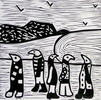
“La promenade”, 1988

same print in color, 3 colors, 3 more blocks
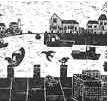

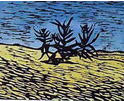
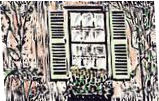
If you like this page, consider sharing it or even better, fund it with
a one time $2 donation, or more if you want to pool money for
future orders of my work, and enjoy special offers.
Do you prefer a 1 or 2 euros donation? Go here, it’s the same
principle.
One of my 1st woodcut, 1985

Playing with lines and color, 1985

© Dominique Lecomte 2014
History of printing relief
Introduction
From 500BC to today, printing relief has a long history, and it is also that history you are buying when you buy an original print. Here is how this article is organized: • Beginning (500BC-100AD and 100-1300) • Printing and relief printing (1300-1450, 1450-1600, 1600- 1800, 1800-1900, after 1900) • Relief printing and artists • RessourcesBeginning
500 BC - 100 AD • Relief printing techniques are first used by the Egyptians to print on fabric (les indiennes). A piece of wood is cut with a knife, and what is left of the drawing is inked and pressed on the fabric. To get more than one color, one has to cut as many woodblocks as there are different patterns. • Stone is used by Chinese artists to make the seals they will use to sign their artworks, but generally speaking, only ethnic groups with no access to wood, like the Inuits, use this material. On this topic, you can consult: An Illustrated History of Printing in Ancient China (English and Chinese Edition)Printing and relief printing
1300 - 1450 • Crusaders bring back to Europe the secret of paper making and relief printing techniques: the 1st known woodcut is called Bois Protat (made around 1375/1400). • Monks are the ones generally making images: inspired by piety, distributed by religious orders, they are intended to evangelize the populations. When pope Clement IV organizes the gifts of indulgences, the production of these images increases dramatically. “Le Nouveau Monde III”, 1997 “Bison couché”, 1999 • Printmakers get their inspiration from stained-glass windows or paintings found in churches; the pictures come with a short text, first hand-written, then cut in the woodblock itself. Later, someone finds out that it is possible to glue the pieces of paper back to back and to bind them together in order to make books. • Secular pictures like heroes of chivalry begin to appear around 1420, and each region has its own style 1450 - 1600 • Gutemberg (1400-1468) makes the first printing machine: texts and pictures are separated and the prints illustrate the stories, but each print can also be seen as stand-alone. Some printmakers start to sign their artworks. Specialized craftsmen take care of each stage of the book-making - creation of the text, illustration, printing, and so on- • Dürer (1471-1528), Holbein (1497-1543), Cranach the Old (1472- 1553) are from this period, and they not only use relief printing techniques, but also etching, mezzotints, and dry points to make prints which later will be be published together as books. To know more about Duere woodcuts (fine, precise) you ou can consult The Complete Woodcuts of Albrecht Dürer (Dover Fine Art, History of Art)
Images, Voyages, Impressions
Original Prints, Photos, Stories, to Smile, Share, Seduce
